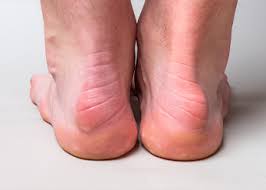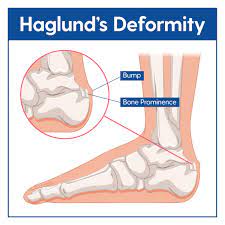HAGLUND'S DEFORMITY - A CAUSE OF HEEL PAIN
- Pete Dal Lago

- Jul 11, 2022
- 2 min read
With its strange name, and one you may not have heard of, this condition is reasonably common and a source of pain and frustration.
A Haglund's deformity is a bony enlargement and irritation of the soft tissue at the back of the heel. It may lead to pain and inflammation. It can be differentiated from Achilles tendinopathy, calcaneal bursitis and plantar fasciitis however these conditions can co-exist, or be caused by a Haglund's deformity.
The above photos illustrate the bony prominence that is formed , and the commonly seen red and irritated soft tissue at the outside of the achilles tendon.
HOW DOES THE BUMP FORM?
The bump is formed from repetitive irritation at the sit of the achilles tendon where it attaches at the calcaneus (heel) bone. It may be due to abnormal load on the tendon and altered biomechanics of the ankle and foot. The soft tissue around the bony enlargement gets irritated and inflamed, commonly due to rubbing against footwear.
CAN IT BE TREATED?
Heel pain is common, and can be from many causes including a Haglund's deformity. Treated needs to focus on the contributing factors. Issues that may contribute include excessive heel rolling inwards during weight bearing (known as excessive rearfoot eversion); tightness in the calf and achilles; over training/excessive running especially uphill; tight fitting footwear; poor calf or gluteal strength altering your biomechanics. A higher foot arch is frequently seen with this condition also, but this can occur as a result of altered biomechanics from a number of factors, rather that just a genetic cause. Your physiotherapist will assess the causes specific to you, and treat each of these as required. In a select number of cases, surgery can be performed to remove the excessive bone at the heel. While successful in many cases, it is invasive surgery and recurrence may occur if contributing factors are not addressed.
Modifying activity, wearing correct fitting shoes, calf and achilles massage and other soft tissue technqiues, as well as performing targeting exercises should be the initial treatment course. Your physio can guide through this treatment process.
Peter Dal Lago
Physiotherapist
References:
Sofka CM, Adler RS, Positano R, Pavlov H, Luchs JS. Haglund's syndrome: diagnosis and treatment using sonography. HSS J. 2006 Feb;2(1):27-9. doi: 10.1007/s11420-005-0129-8. PMID: 18751843; PMCID: PMC2504114.
Vaishya R, Agarwal AK, Azizi AT, Vijay V. Haglund's Syndrome: A Commonly Seen Mysterious Condition. Cureus. 2016 Oct 7;8(10):e820. doi: 10.7759/cureus.820. PMID: 27843738; PMCID: PMC5101401.






Comments